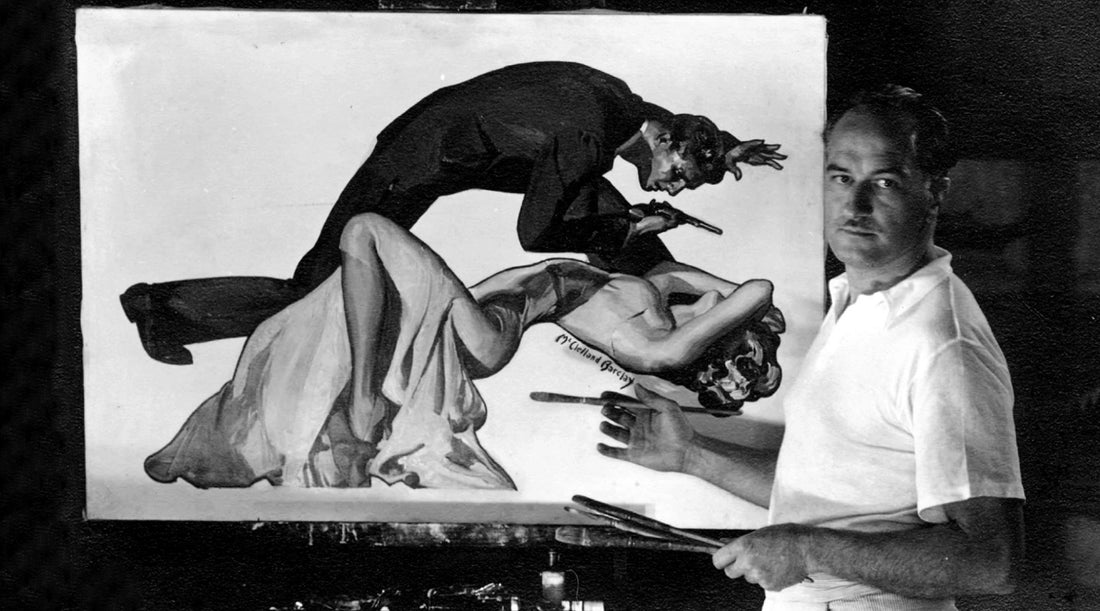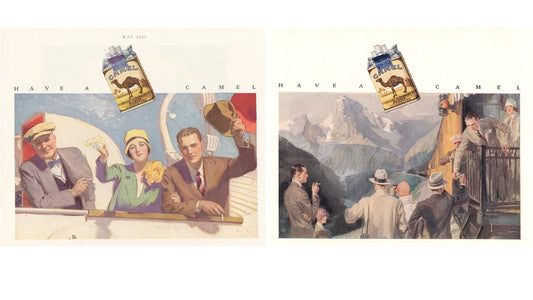
How Mac's 1933 mystery story illustration became an MGM movie starring Myrna Loy
Share
Story illustration was becoming a steady stream of work for McClelland Barclay by the early 1930s. Barclay was already a successful commerical artist known for illustrating glamorous Fisher Body ads for GM automobiles. His illustrated magazine cover art began regularly appearing in Pictorial Review, Country Gentleman, Saturday Evening Post, The Ladies’ Home Journal, among others.
McClelland Barclay paints the dramatic opening story illustration for "Penthouse", the mystery by Arthur Somers Roche, published as a series in Cosmopolitan, May-September 1933.
In Chapter Two of my book, The Illustrator, I describe some of Barclay's editorial story illustration work, and how one can recognize his style:
While McClelland's advertising art was making him a household name, his fame as a story illustrator was ensured through his work for Cosmopolitan magazine from 1930 until his death in 1943. Echoes of McClelland Barclay’s Fisher Body Girl are evident in some of his magazine covers and story illustrations.
Illustrated short stories were popular magazine content in the early days of mass print media. Hearst's Cosmopolitan, regularly published illustrated short stories, keeping readers in suspense, month after month.
Barclay was one of a handful of artists regularly called upon by America’s most popular magazines to illustrate serial stories. Several were turned into movies. Penthouse was one of them.
Barclay illustrates Penthouse mystery story for Cosmopolitan
The May 1933 issue of Hearst’s International Cosmopolitan magazine included the first installment of “Penthouse” by Arthur Somers Roche, a melodramatic gangster murder mystery. To illustrate the story, Cosmopolitan commissioned McClelland Barclay to paint ten dramatic scenes.
The "Penthouse" series was published in the May through September 1933 issues of Cosmopolitan, each with story illustrations painted by McClelland Barclay.

Above: "Penthouse" story Illustration by McClelland Barclay, Cosmopolitan, June 1933
“Penthouse” illustrated story becomes a movie starring Myrna Loy
The "Penthouse" illustrated story was late in the genre of gangster themes. But widespread readership led Metro-Goldwyn-Mayer to believe it still had box office potential. In late May 1933, the same month as the magazine story debut, MGM snapped up the movie rights in a co-production deal with Cosmopolitan.
MGM has bought Arthur Somers Roche story, "Penthouse," now running in the Cosmopolitan. - The Hollywood Reporter, Thursday, May 25, 1933.
MGM quickly began filming that summer, while Cosmopolitan continued publishing the series with two story illustrations by McClelland Barclay in each issue. Myrna Loy, one of Hollywood’s popular leading ladies, was cast as the call girl Gertie Wexter. Martha Sleeper played Sue, the society fiancee to Jack Durant, the lawyer, crime solver and both ladies’ love interest, played by Warner Baxter. W. S. Van Dyke directed.

LEFT: MGM 1933 "Penthouse" publicity photo of Myrna Loy (gown by Adrian), courtesy IMDB.
RIGHT: McClelland Barclay’s story illustration of Penthouse by Arthur Somers Roche, Cosmopolitan, May 1933. Illustrating the scene: “Someone for you, Jack,” said Sue. Durant’s eyes widened in surprise. Then a man’s voice said: “Just a friend of yours telling you to lay off the Siddall case.”
Box Office Champion
Cosmopolitan published the conclusion of Penthouse in the September issue. Perfectly timed for the Penthouse film opening on the silver screen on September 8, 1933.
Reviewed the next day as “a good audience picture”, for theatre owners in Motion Picture Herald, appealing to both men and women, and because it’s a Cosmopolitan Magazine story. Harrison’s Reports on September 16 called it, "A fast-moving gangster melodrama, with racy dialogue and much comedy." The December 1933 issue of fan magazine Photoplay, described it a "standard melodrama about a 'high life' murder, but thrillingly done.”
The combination of Cosmopolitan’s mass audience, MGM’s high value production and stars like Myrna Loy, helped this film achieve box office success. In The Box Office Champions for September, The Motion Picture Herald ranked Penthouse third top film based on theatre box office receipts in the month following its release. Penthouse tied with The Masquerader (United Artists) and Captured (Warner Bros). The MGM and Saturday Evening Post co-production of Tugboat Annie was number one; followed by Morning Glory starring Katharine Hepburn (RKO Radio) in the number two spot.
A steady stream of illustrated stories and stars
Short stories were an affordable escape from reality costing 25 cents an issue. Illustrated stories hooked readers, and helped publishers sell magazines and movie rights to Hollywood studios.
The Hollywood movie making machine quickly produced these stories in the new medium of ‘talkies’. For another 25 cents admission, illustrated stories could be enjoyed a second time as motion pictures on the silver screen while the plot was still fresh in readers minds. Penthouse was just one of many illustrated short stories that were made into movies during those tough Depression days.
McClelland's cinema artwork appeared nationally on movie posters (above right: Hotel for Women, 1939) and billboards, and in magazine and newspaper ads. During the 1930s and early 1940s, he painted stars including Jean Harlow and Joan Crawford for popular fan 'zines like New Movie Magazine, and Photoplay...and even appeared on screen as himself in Paramount's 1937 Artists and Models!
During the 1930s Barclay also began pursuing other avenues of commercialization, launching McClelland Barclay Art Products, Inc. The business began producing his designs for home decor accessories like this pair of Art Deco style aluminum vases (shown above) which are similar in design to the ones on the mantle beside Myrna Loy in her Penthouse publicity photo. In yet another Hollywood connection, Barclay's art product business was eventually bought in 1939 by Dodge, Inc., maker of the golden Oscar statue between 1936 and 1983. McClelland Barclay by Dodge is the maker's mark on the back of the gold tone aluminum shell dish with grapes made c. 1940. (shown above).
Extraordinary Acts: much more to the story for both McClelland Barclay and Myrna Loy
Under contract with MGM, Myrna Loy was one of the busiest leading silver screen stars of 1933. That year she also appeared in Topaze, released in February; When Ladies Meet, in June, Night Flight in October and The Prize Fighter and the Lady in November. The next year, her career took off with another MGM movie, The Thin Man, based on the novel by Dashiell Hammett. By 1937 Myrna Loy was among Hollywood’s highest paid actors and a fan favourite of North American moviegoers and U.S. President, Franklin D. Roosevelt.
Although never nominated for an Oscar, in March 1991 Myrna Loy received an Honorary Academy Award in recognition of her life's work both onscreen and off. During WWII she performed in fundraising benefits for Franco-British War Relief, Bundles for Britain, and the Red Cross. In 1941, Loy joined the Hollywood Victory Campaign and put on a blue uniform to run the Naval Auxiliary Canteen at Long Beach, and pledged monthly support for the U.S. Navy. She also did promotional reels for War Bond drives, and appeared in the March 1942 Navy Relief Show at Madison Square Garden in New York.
In April 1943, she joined the American Red Cross as an unpaid assistant to the director of the Military and Naval Welfare Service, helping to set up visits to military hospitals by Broadway and Hollywood performers. (Ref; Myrna Loy, Her World Beyond Hollywood, Part 1 1905-1949, by Dr. Greg Badsher, Senior Archivist, National Archives, Dec 14, 2017)
I wonder if Myrna Loy ever met McClelland Barclay, the original illustrator of Loy’s Penthouse character.
McClelland Barclay's WWII illustrations: Nalani de Clercq, USO performer; U.S. Navy Sailor in action on a Navy Relief show program, Madison Square Garden March 10, 1942, where Myrna Loy was among the stage, screen and radio stars performing.
Barclay also put his artistic skills to work during wartime. Years before illustrating Penthouse, he was creating posters for the U.S. Red Cross Fund during WWI. He enlisted in WWII and became a Lieutenant in the U.S. Naval Reserve illustrating Navy recruiting posters, and documenting Naval officers and ordinary sailors and USO entertainers. But I will save those parts of this multidisciplinary artist’s story for another post...
You can watch Myrna Loy in the original trailer for Penthouse (1933). Perhaps think about the extraordinary acts of these two artists. While their fame may be fading, both performed heroic wartime acts that are worth remembering.









